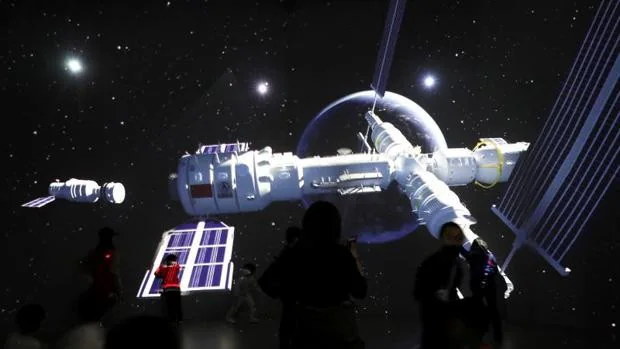 After five in the morning (Spanish peninsular time), China launched the first module of what will be its future space station from the island of Hainan aboard a Long March 5B rocket. The component, called Tianhe (Harmony of the Heavens), is the central and most important part of the new 'T'-shaped orbital platform that the Asian giant plans to have ready in 2022.
After five in the morning (Spanish peninsular time), China launched the first module of what will be its future space station from the island of Hainan aboard a Long March 5B rocket. The component, called Tianhe (Harmony of the Heavens), is the central and most important part of the new 'T'-shaped orbital platform that the Asian giant plans to have ready in 2022.
The heavy-lift carrier rocket, with a height equivalent to an 18-story building and weighing 849 tons, has lifted off from the Wenchang Space Launch Center with the mission of placing the 22.5-ton capsule, the largest spacecraft largest and heavy that China has ever built, into a low orbit about 400 kilometers above Earth. The weight of the ship is equal to that of 15 normal-sized cars.
Launch of Long March 5B with the Tianhe module on board
–
AFP
The multi-module space station, called Tiangong (Heavenly Palace), will mainly consist of a core module attached to two space laboratories, with a combined weight of nearly 70 tons. Tianhe has three parts: a connection section, a control and life support section, and a resource section. This module will be essential for future operations of the space station, as astronauts will live there and control the entire station from the inside. It will also be used to host scientific experiments.
Astronauts from the Shenzhou XII and XIII missions and two freighters will launch within a few months to prepare the module for docking with other parts of the station. Next year, Tiangong's two space laboratories, two manned missions and two robotic cargo flights will be sent to continue construction of the platform.
China is not a partner of the International Space Station (ISS), in which NASA, the European Space Agency (ESA), Japan and Canada participate. On the contrary, for a decade it has been demonstrating its intention to have its own home in space. The construction of the space station marks the beginning of the third stage of China's manned space program, which was approved by the government in 1992.
In September 2011, China launched its first space laboratory, Tiangong 1, to test the technologies needed to assemble and maintain a large space station in Earth orbit. It was visited by two manned missions, that same year and in 2012, which remained on board for two weeks. It fell uncontrollably over the South Pacific in April 2018.
China's second space laboratory, Tiangong 2, was launched into orbit in September 2016. Three astronauts stayed there for a month. This platform also crashed into the Pacific in July 2019, although on this occasion the operation was controlled.
When ready, the future Chinese space station will weigh about 460 tons (on Earth), more than the ISS, and will house three astronauts, while the ISS can fit six or seven. As reported by 'Scientific American', it will have 14 positions to carry out experiments inside and 50 external docking points for instruments to collect data in the space environment. Apparently, there are already a hundred selected experiments that can begin to be carried out next year.
The facility will also be able to dock with multiple crew and cargo spacecraft at the same time and will be able to dock with foreign spacecraft if they have a designated docking hatch.
The entire Tiangong station is expected to become fully operational by the end of 2022 and is scheduled to operate for about 15 years, mission planners have indicated, cited by the Chinese Space Agency (CNSA) in a statement. Once completed, the station will be accompanied by an optical telescope.
